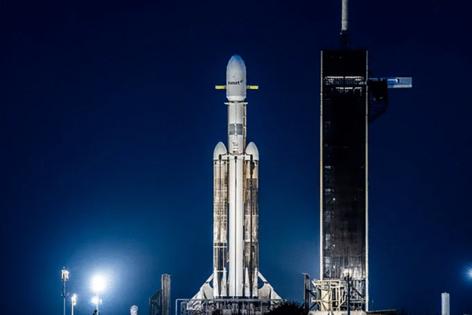Year's 1st SpaceX Falcon Heavy launch on tap Tuesday with NOAA satellite
Published in Science & Technology News
SpaceX is locked and loaded for what would be only the 10th launch for its powerhouse Falcon Heavy rocket Tuesday, scheduled to take a powerful weather satellite to space if weather cooperates.
The payload is the 11,000-pound GOES-U satellite for NASA and the National Oceanic and Atmospheric Administration, headed to geostationary orbit where next year it will take on the duties of scanning the Atlantic Ocean for tropical threats as well as other dangerous weather affecting the United States.
“GOES-U … will be the sentinel in the sky to keep an eye on hurricanes,” said Dan Lindsey, the chief scientist of NOAA’s GOES program, during a press conference Monday. It will also continue to scan Central America, the Caribbean and South America as well as add to the lightning and wildfire observation capability in the U.S.
Liftoff is targeted at 5:16 p.m. from Kennedy Space Center’s Launch Pad 39-A at the opening of a two-hour window, with a backup during the same window on Wednesday. NASA plans launch broadcast coverage on NASA TV and its social media channels beginning at 4:15 p.m.
Space Launch Delta 45’s weather squadron forecasts only a 30% chance for good conditions for either launch day, though. Deep tropical moisture is expected to remain over Florida this week, increasing afternoon storm chances with the threat of lightning near the launch site.
Two of the three boosters on the rocket will attempt a recovery touchdown back at nearby Cape Canaveral Space Force Station’s Landing Zones 1 and 2, which could mean one or more sonic booms may be heard across the Space Coast and into Central Florida. The center core booster will crash into the Atlantic with no recovery planned.
The GOES-U satellite is the 19th Geostationary Operational Environmental Satellite (GOES) satellite launched since 1975, and will inherit the name GOES-19 once it makes it to space. It’s the fourth and final of what is known as the GOES-R series that first launched in 2016.
“The GOES-R series creates a full disk (view) of the Earth every 10 minutes,” said National Weather Service Ken Graham. “So our weather service meteorologists often request enhanced scanning of rapidly evolving storms.”
GOES-16 is the satellite that currently looks at the Atlantic. GOES-16 will retire from that role once GOES-U (soon to be GOES-19) is in place at 22,000 miles above Earth before the start of the 2025 hurricane season.
The spacecraft also has a new space weather tool, a sun-facing instrument targeting coronal mass ejections such as those that bombarded Earth with geomagnetic storms in May and pose a threat to the nation’s electrical and communication grids.
...continued
©2024 Orlando Sentinel. Visit orlandosentinel.com. Distributed by Tribune Content Agency, LLC.







Comments